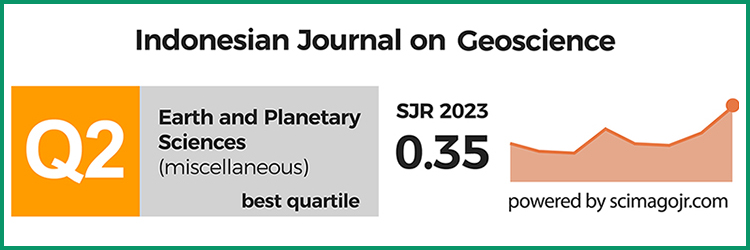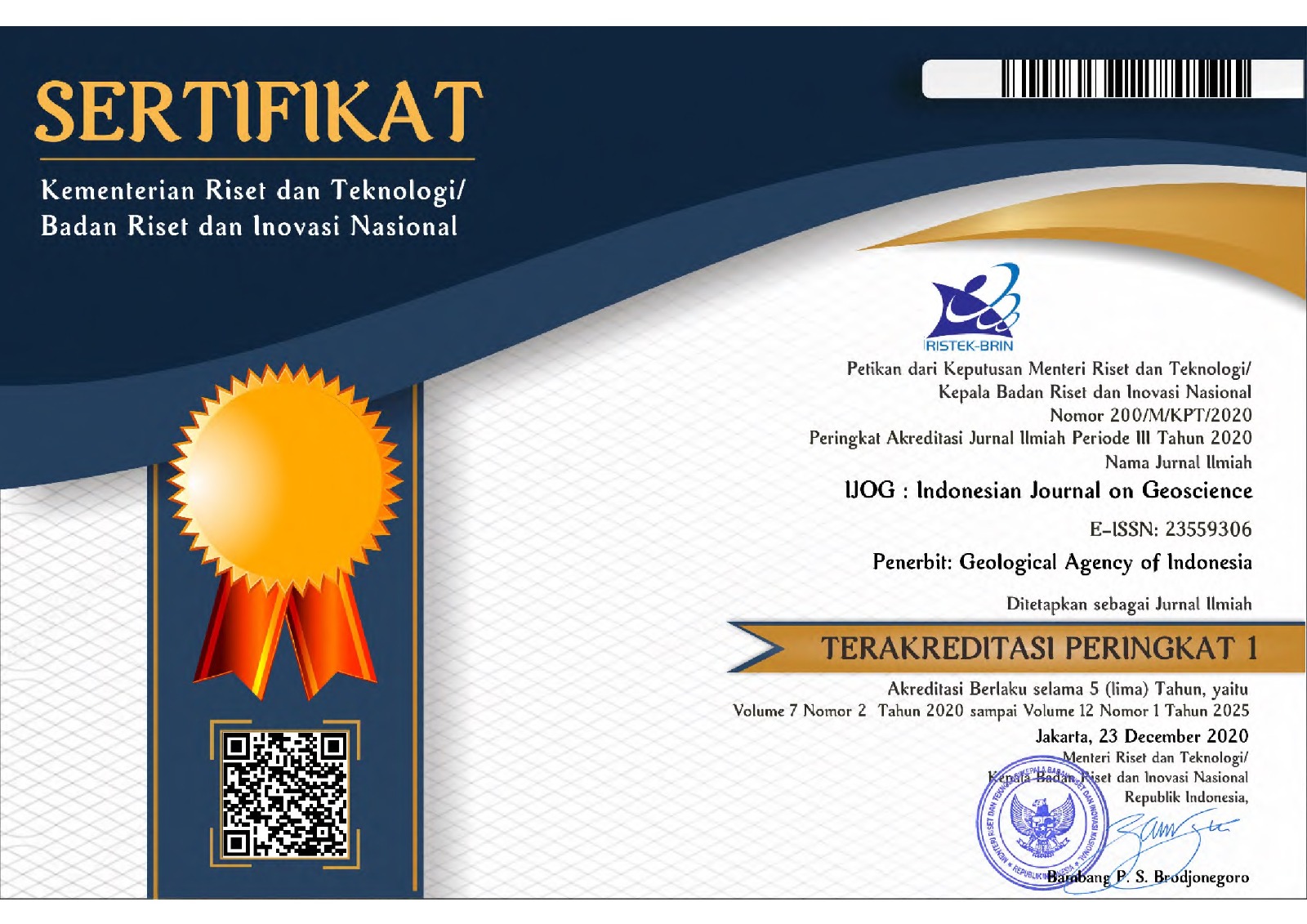Soil Infiltration Rate Prediction using Machine Learning Regression Model: A Case Study on Sepinggan River Basin, Balikpapan, Indonesia
DOI:
https://doi.org/10.17014/ijog.10.3.335-347Keywords:
Infiltration rate, multiple regression, machine learning, initial water contents, grain size, soilsAbstract
The infiltration rate of soil data is important in a wide range of planning, such as city planning, drainage design, landuse planning, flood prediction, flood disaster mitigation, etc. Collecting data of infiltration through in-site direct measurements is time consuming and costly. Indeed, inferring the infiltration rate using available parameters and the fittest model is needed. The model can shortcut the field measurement to get a predicted accurate infiltration rate that is worthy to support vital planning. This research aims to develop a model of infiltration rate based on initial water contents and grain size of soils. The results are three outstanding models based on the Multiple R Squared, Root Mean Square Error (RMSE), and Mean Average Error (MAE). The implication of the fittest model is reducing the cost and time to get the predicted infiltration rate. The field measurements can be skipped by sampling undisturbed soils and laboratory tests.
Keywords: infiltration rate, initial water contents, grain size
References
ALENCOÃO, A. M. P., & PACHECO, F. A. L. (2006). Infiltration in the Corgo River basin (northern Portugal): coupling water balances with rainfall-runoff regressions on a monthly basis . Hydrological Sciences Journal, 51(6), 989–1005. https://doi.org/10.1623/hysj.51.6.989
Angulo-Jaramillo, R., Bagarello, V., Iovino, M., & Lassabatere, L. (2016). Infiltration measurements for soil hydraulic characterization. In Infiltration Measurements for Soil Hydraulic Characterization. Springer International Publishing. https://doi.org/10.1007/978-3-319-31788-5
Bergeson, C. B., Martin, K. L., Doll, B., & Cutts, B. B. (2022). Soil infiltration rates are underestimated by models in an urban watershed in central North Carolina, USA. Journal of Environmental Management, 313, 115004. https://doi.org/10.1016/j.jenvman.2022.115004
Bhave, S., & Sreeja, P. (2013). ISH Journal of Hydraulic Engineering Influence of initial soil condition on infiltration characteristics determined using a disk infiltrometer Influence of initial soil condition on infiltration characteristics determined using a disk infiltrometer. https://doi.org/10.1080/09715010.2013.808445
Carslaw, D. (2019). The openair manual — open-source tools for analysing airpollution data. Manual for version2.6-6,University of York. November, 224. https://davidcarslaw.com/files/openairmanual.pdf
Dahan, O., Shani, Y., Enzel, Y., Yechieli, Y., & Yakirevich, A. (2007). Direct measurements of floodwater infiltration into shallow alluvial aquifers. Journal of Hydrology, 344(3–4), 157–170. https://doi.org/10.1016/J.JHYDROL.2007.06.033
Formansya, S., Gani, R. M., Firmansyah, Y., & Hermato, W. (2020). SUMBERDAYA SEAM BATUBARA FORMASI PULAU BALANG DI PT. ANUGERAH BARA KALTIM, KECAMATAN LOA JANAN, KABUPATEN KUTAI KARTANEGARA, KALIMANTAN TIMUR . Padjadjaran Geoscience Journal, 4(6). https://journal.unpad.ac.id/geoscience/article/view/32191/15018
Fueki, N., Lipiec, J., Kuś, J., Kotowska, U., & Nosalewicz, A. (2012). Soil Science and Plant Nutrition Difference in infiltration and macropore between organic and conventional soil management. https://doi.org/10.1080/00380768.2011.644759
Juwita, R., & Santoso, I. B. (2019). Assessment of Soil Infiltration Capability in Balikpapan City. IPTEK Journal of Proceedings Series, 0(5), 291–297. https://doi.org/10.12962/J23546026.Y2019I5.6341
Khosravi, K., Ngo, P. T. T., Barzegar, R., Quilty, J., Alami, M. T., & Bui, D. T. (2022). Comparing the Soil Conservation Service model with new machine learning algorithms for predicting cumulative infiltration in semi-arid regions. Pedosphere, 32, 2–27.
Kiptiah, M., Azmanajaya, E., & Giarto, R. B. (2020). ANALISIS LAJU INFILTRASI DENGAN VARIASI PERMUKAAN TANAH DI KOTA BALIKPAPAN. JURNAL SIPIL SAINS, 10(2). https://doi.org/10.33387/SIPILSAINS.V10I2.2261
Ma, J., Zeng, R., Yao, Y., Meng, X., Meng, X., Zhang, Z., Wang, H., & Zhao, S. (2022). Characterization and quantitative evaluation of preferential infiltration in loess, based on a soil column field test. CATENA, 213, 106164. https://doi.org/10.1016/J.CATENA.2022.106164
McIntyre, D. S., & Sleeman, J. R. (1982). Macropores and hydraulic conductivity in a swelling soil. Soil Research, 20(3), 251–254. https://doi.org/10.1071/SR9820251
Michael, A. M. (2010). Irrigation : theory and practice. 768.
Ruggenthaler, R., Meißl, G., Geitner, C., Leitinger, G., Endstrasser, N., & Schöberl, F. (2016). Investigating the impact of initial soil moisture conditions on total infiltration by using an adapted double-ring infiltrometer. Journal, 61(7), 1263–1279. https://doi.org/10.1080/02626667.2015.1031758
Setiawan, O., Sartohadi, J., Pramono Hadi, M., & Mardiatno, D. (2019). Physical Geography Infiltration characterization using principal component analysis and K-means cluster analysis on quaternary volcanic landscape at the southern flank of Rinjani Volcano, Lombok Island, Indonesia. https://doi.org/10.1080/02723646.2019.1620526
Sihag, P., Singh, V. P., Angelaki, A., Kumar, V., Sepahvand, A., & Golia, E. (2019). Modelling of infiltration using artificial intelligence techniques in semi-arid Iran. Hydrological Sciences Journal, 64(13), 1647–1658. https://doi.org/10.1080/02626667.2019.1659965
Sulistyo, T. (2018). IDENTIFICATION AQUIFER PARAMETERS THROUGH SINGLE WELL PUMPING TEST SERIES AT PT. KALTIM KARIANGAU TERMINAL, BALIKPAPAN, EAST KALIMANTAN. 3(2), 293–300.
Sulistyo, T., & Abrar, A. (2017). Characterization of Thin Alluvial Bed Aquifers in Manggar River Balikpapan East Kalimantan Indonesia. JTT (Jurnal Teknologi Terpadu), 5(1), 54. https://doi.org/10.32487/jtt.v5i1.212
Sy, N. L. (2006). Modelling the infiltration process with a multi-layer perceptron artificial neural network. Hydrological Sciences-Journal-Des Sciences Hydrologiques, 1, 51. https://doi.org/10.1623/hysj.51.1.3
Thomas, A.-D., Austin, A., William, A., Eric, O. D., Alex, A. A., Maxwell, B., Isaac, L., Gilbert, A. A., & Duke, Q. N. D. (2022). Performance evaluation of infiltration models under different tillage operations in a tropical climate. Scientific African, 17, e01318. https://doi.org/10.1016/J.SCIAF.2022.E01318
Tikaram, G., Sikar, T., Singh, K., Sudhir, R. &, Singh, K., Tikaram Patle, G., Rawat, K. S., & Singh, S. K. (2018). Estimation of infiltration rate from soil properties using regression model for cultivated land. https://doi.org/10.1080/24749508.2018.1481633
Downloads
Published
Versions
- 23-11-2023 (2)
- 17-11-2023 (1)



















